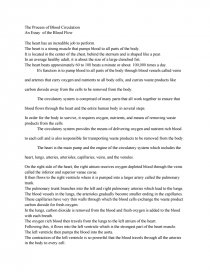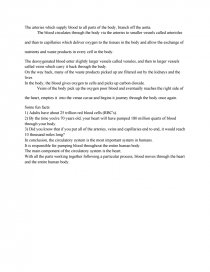The Process of the Blood Circulation
Essay by people • December 20, 2011 • Essay • 682 Words (3 Pages) • 1,365 Views
The Process of Blood Circulation
An Essay of the Blood Flow
The heart has an incredible job to perform.
The heart is a strong muscle that pumps blood to all parts of the body.
It is located in the center of the chest, behind the sternum and is shaped like a pear.
In an average healthy adult, it is about the size of a large clenched fist.
The heart beats approximately 60 to 100 beats a minute or about 100,000 times a day.
It's function is to pump blood to all parts of the body through blood vessels called veins and arteries that carry oxygen and nutrients to all body cells, and carries waste products like carbon dioxide away from the cells to be removed from the body.
The circulatory system is comprised of many parts that all work together to ensure that blood flows through the heart and the entire human body in several steps.
In order for the body to survive, it requires oxygen, nutrients, and means of removing waste products from the cells.
The circulatory system provides the means of delivering oxygen and nutrient rich blood to each cell and is also responsible for transporting waste products to be removed from the body.
The heart is the main pump and the engine of the circulatory system which includes the heart, lungs, arteries, arterioles, capillaries, veins, and the venules.
On the right side of the heart, the right atrium receives oxygen depleted blood through the veins called the inferior and superior vanae cavae.
It then flows to the right ventricle where it is pumped into a larger artery called the pulmonary trunk.
The pulmonary trunk branches into the left and right pulmonary arteries which lead to the lungs.
The blood vessels in the lungs, the arterioles gradually become smaller ending in the capillaries.
These capillaries have very thin walls through which the blood cells exchange the waste product carbon dioxide for fresh oxygen.
In the lungs, carbon dioxide is removed from the blood and fresh oxygen is added to the blood with each breath.
The oxygen rich blood then travels from the lungs to the left atrium of the heart.
Following this, it flows into the left ventricle which is the strongest part of the heart muscle.
The left ventricle then pumps the blood into the aorta.
The contraction of the left ventricle is so powerful
...
...

